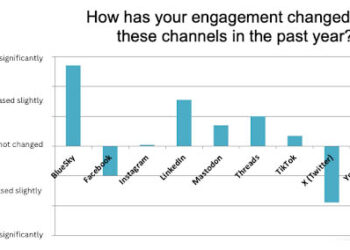 London Heathrow may have lost its crown as the world’s busiest international airport, but it probably retains its claim to some of the world’s oddest customer enquiries – who else gets asked:
London Heathrow may have lost its crown as the world’s busiest international airport, but it probably retains its claim to some of the world’s oddest customer enquiries – who else gets asked:
- What’s the difference between a toilet and a loo?
- Where can I exchange currency for some Scottish dollars?
- Are there ATMs in central London? Can you mark them on my map?
These and other gems are shared in a a “Top 10 strangest passenger requests” list on Heathrow’s “information and help in the terminals” web page. Top 10s, indeed lists of any length, are a classic tool of the content marketer, and Heathrow’s is a fine example of the genre – appealing to a broad audience, with plenty of hooks to drive deeper interest; human in tone and scope, with touches of nostalgia and humor; not explicitly advertising anything, but subtly connected to a service being provided.
The list caught my attention because I was still musing on a seminar about content marketing, organized by ALPSP as part of the program in the London Book Fair’s “Faculty” theatre. The session was chaired by Wiley’s Kate Smith, and featured the Royal Society of Chemistry’s Laura Finn, Amy Nicholson from Sticky Content (part of the Press Association) and TBI Communications’ Lynne Miller. The speakers built a strong case for content marketing as a medium for connecting with customers at a deeper and longer-term level — critical objectives for scholarly publishers as competition increases for the best research and researchers.
Content marketing, of course, is the technique of building visibility and reputation by creating materials that contribute to the discourse around key issues — without directly publicizing your products. I say “of course”, but there’s the rub: one view of those in attendance is that scholarly publishers misunderstand content marketing, confusing it for simply marketing content. It is a difficult distinction to make when the content you are marketing is in itself comprised of discourse around key issues. That is to say, it’s hard to draw lines between “product marketing” and “content marketing” when product = content.
Or is it? Most groups I’ve worked with are struggling with content marketing not because it’s hard, but because they haven’t comprehensively committed to doing it. Content marketing doesn’t lend itself as well as one might assume to dipping a toe in the water. Much like swimming, before you get anywhere or impress anybody, you have to put in some time, learn from some experts, and build confidence. It helps if you have a natural aptitude and / or a good support team. Standing fully clothed on the edge will not get you anywhere; if this is the mode you choose, committing to it fully will be a lot more effective than fadaddling in the shallows. Like its close relative social media marketing1, good content marketing requires:
- A strategic framework. What are we trying to achieve? How much are we prepared to invest in that goal? How will we define “success”, and measure progress towards it? How will we quantify the effort expended in getting there?
- A clearly defined brand. What debates are relevant to us? What causes do we espouse? What characteristics do we want to convey?
- Knowledge of our topics. What is the significance of what we are publishing? To which wider trends does it relate?
- Authority to engage. Who do we trust to be a mouthpiece for the organization? How can we give more people the confidence to step up? Who needs to buy into content marketers stepping away from the product and engaging in broader conversations?
- Time to dedicate. How will we make space for thinking, research, writing, editing, revising and following up responses to the content created?
Individuals or organizations who can tick off all of these are rare; the strategic and brand frameworks are often the pieces most conspicuous by their absence, and authority is also a common obstacle. All these points are interconnected, too; it’s no coincidence that the publishers who are best at content marketing are the ones with strong brands – think Nature, or PLOS. If we have a clearly defined brand, we can trust more people to represent it than if it is just a nebulous concept in the heads of senior executives; if we have set up our strategic framework, we can make an informed decision about how much time to dedicate.
In summary, while the substance of our content marketing needs to come from the ground up – it is similar to grassroots marketing in the need to listen and appeal to a specific target group – the commitment to it, and the framework for it, needs to come from the top down. If there is a sense that publishers are not yet getting it right, the answer lies not only in better knowledge-sharing and collaboration at the coalface (e.g. to ensure that content marketing doesn’t fall in the gaps between marketing and editorial, or in bigger organizations, between marketing and PR) but also in better support and structure further up the organization (e.g. making sure everyone knows what the organization stands for, and is thereby empowered to speak on its behalf).
Finally, a striking title is all very well, but a good content marketer makes sure it is rooted in the content itself. So I close with one more list of tips for getting started in content marketing:
- Strip off: pare down your goals so that you are focused on a defined strategy for a defined audience – without focused objectives, it will be hard to know what kinds of activities to pursue, and how to measure them
- Jump in: don’t fadaddle in the shallows. Decide whether content marketing is the right tool for your organization, define your strategy, and then embrace it fully if you want to see return on your investment.
- Splash out – in two senses: a) recognize that content marketing is an investment to which you must commit if you want to see a return; b) focus that investment wisely by finding conversation areas in which you won’t be afraid to make waves (so your efforts don’t sink without trace).
The talks at the seminar were well-tweeted (see TBI’s Storify) and blogged by ALPSP. If examples come to mind of publishers doing content marketing well, please do share them in the comments!
1 What is the difference between social media marketing and content marketing? Social media has certainly driven the rise in content marketing, not least by providing good channels for building an audience for content marketing activities. In the context of this post, social media marketing might best be considered as a subset of content marketing – one medium through which to communicate, alongside others such as PR (e.g. speaking engagements, media articles).
Discussion
12 Thoughts on "Strip Off, Jump In, Splash Out – How to Swim in Content Marketing Waters"
In the case of scholarly societies, should the content speak to the members (as the audience) or for the members (to another audience)? Or are these just two different options, both viable? It might be a delicate distinction.
Hi David – it would of course depend on the overall strategic context in which content marketing is being deployed; as a marketing approach, I could see it serving both of these goals and as you say, some content could in itself appeal to both of these audience.
True, Charlie, but the case I have in mind is where the society takes a position on a controversial topic, which some of its members then strongly disagree with. Societies are not like those normal organizations which can decide what the organization believes. It can be counter productive for a society to take a strong position on a controversial issue, especially if that position is not built into the society’s mission. A certain amount of delicacy may be called for when it comes to speaking for the members.
Indeed, and that’s where the issue of authority really comes to the fore – who do you trust to have the necessary delicacy? Any content marketing with the potential to be so controversial would probably be coming from pretty high up the organisation where you’d hope the sensitivities would be well understood although again, societies are a special case because of the regular changes in leadership. A good brand platform can help create some consistency and provide a framework against which to test potential commentary – for example, I can envisage a number of ways in which the BMA might have considered whether its response to developments in the medical world was a fit for its “standing up for doctors” brand idea. Of course one can’t get it right all the time – because one’s members are never entirely in agreement – but if you have a brand strategy that has been informed by members’ views then it should prove a good navigation aid more often than not.
For what purpose are you marketing the thing you are marketing? Is it a book or a journal? To market journals in order to increase subscriptions is folly. Those who would read the journal know about it and either the library subscribes or not – budgets you know!
Books! Books are very small market items and the vast majority of S&T publishers have settled for the grand marketing strategy of 300 copies and a cloud of dust. To reach more of the market a publisher may invest in an e mail campaign and hope eyes see the blurb before the spam file devours it.
Thus, it seems to me that content marketing is just another name for marketing because social media marketing was just another name for X marketing.
Thus, what we have in the 5 points are principles of marketing. Regarding product knowledge – point 3. I think that really has to be defined. Knowledge laden statements should be reviewed by the author or journal’s editor in chief. This is where marketing gets in real trouble with their audience. We deal with very smart people. Nothing is more embarrassing than making a statement and then being asked a knowledge laden question regarding something we have said and then trying to answer it with fluff, folderol and air!
Hi Harvey, I think content marketing can work most effectively at the brand level – so it may not be specifically marketing a book or a journal, but instead building a broader awareness of what the publisher stands for. For example, I think SAGE have produced some nice content marketing over the years that has not been specifically aimed at building sales for a particular publication, but have helped demonstrate their passion for and expertise in certain fields or topics (e.g. research methods).
You’re absolutely right that some of the 5 points above are not specific to content marketing; all marketing activity requires a strategic framework, all marketers need to understand the brand and (at least at an entry level) the topic areas in which they are marketing. I think the level of knowledge required is greater for content marketing than for other forms of marketing, precisely because of your point that content marketing is an interaction – one needs to be able to respond knowledgeably, in a way that isn’t necessarily required of other forms of marketing e.g. direct mail or email campaigns – typically a message is pushed out, with no expectation of reply. That message can indeed be approved by e.g. the author or the editor; hence the difference with content marketing is the need for a level of knowledge and authority that can support a more interactive conversation.
This is a very good post, which I am delighted to find here on the Kitchen. I wish to make one point: the kind of marketing created here lends itself to organizations that already have significant market share in a particular area. If you are marketing (in the sense of creating awareness) for a field, the marketing has a higher return to those organizations that have more properties in that area.
Content marketing is a very effective tool, but its effectiveness varies with actor. Both social media and content marketing (the latter is a subset of the former) are themselves components of a broader strategic marketing plan.
Thank you, Joe! I had been thinking again about the relationships between social media and content marketing – actually it seems sort of obvious to me now that one is the medium and one is the message. So social media is a vertical – one silo of communication. Content marketing is a horizontal – one type of message that may be communicated by multiple channels.
In any case, content marketing may indeed be an easier investment to justify if you are a substantial organisation with a bigger footprint across which to evaluate / apply the success of your efforts. But it can also punch above its weight as a mechanism for building visibility for a small organization – if, as you say, you have the right person(ality) driving it.
One example of successful collective content marketing, I would suggest, is the AAUP’s Books for Understanding program, which was established in the wake of 9/11 to help the general public, and especially journalists writing on current news topics, to be aware of the deep resources available in academic books that can provide background knowledge for people seeking to understand what is happening in the world today. The AAUP brand provides assurance that the content has been thoroughly vetted, and it is organized into subject areas and constantly updated.
Hi Sandy – it’s a great program and a smart idea for surfacing a rich source of information, but I think of Books for Understanding as marketing content, rather than content marketing – it’s rooted in the publications, rather than being a separate but related discourse, and is designed ultimately to increase readership / sales of the books. If there was a layer of commentary on top of the bibliographies, that wasn’t specific to any one text but was generally leading some thought on the topic, that would “qualify” as content marketing for me!
Thanks for a thoughtful and enlightening post. I particularly like your observation about the need for whole company engagement. Empowering all staff to think creatively about their day to day work and how it might be transformed into relevant, valuable content for their community is no small task. That’s a seismic shift for many organizations right there.
As a trained direct marketer (who completed my qualification in the *coughs* last century *coughs*) I’m struck how it seems light years away from traditional CRM. On the face of it, content marketing seems so soft and unscientific when compared to the raft of measures and accountability we are trained to expect.
But there are different metrics emerging that measure success. And in a noisy online environment, a more rounded, balanced, and potentially long term approach to multi-channel branded communication is now required to seal the deal.
Excellent post. As someone who is responsible for the content marketing for a small business I would reinforce that one cannot underestimate the amount of time that is needed for the creation of good content. Content marketing is a hungry beast that requires constant feeding to be effective. It works for both large and small companies, startups and category leaders. It is a great way to harvest prospects. But it takes a lot of time and effort to do well.



